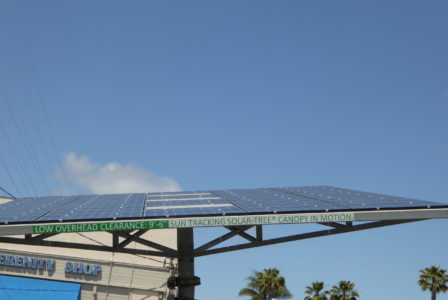Facts and Ideas about Conserving Resources – Part 1
Last May the Mission Hills Garden Club, accompanied by Tiger Palafox, spent a few hours at San Diego Gas and Electric Innovation Center. It was an interesting meeting. Ravina, an incredibly enthusiastic employee, led us on a tour.
Our tour began with a visual history of conservation beginning in the late 1960s. At that time California had a population of about 16 million people. When new laws halted constructions of dams, it became clear that we would need sources other than dams for power. By the 70s, it seemed we would need 30 new power plants to meet the 21st century’s demands. Rather than build more plants, California decided to adopt energy efficient means to meet this growing need for power.
California had grown to 24 million people by the 1980s. It was the first state to separate the sale of electricity from profits allowing utility companies to help customers use less energy. In the 90s the federal government launched Energy Star© which “became the standard for the most energy efficient products on the market,” according to one of the larger-than-life displays. California was now home to 30 million people. By the new century the population had grown to 34 million. The goal was to serve the plethora of customers without harming the climate. This necessitates implementing changes and developing more strategies to conserve energy and finding new ways for the customers to save.
Clever engineering takes advantage of our mild climate. To illustrate, Ravina asked us to look carefully at the south facing windows. Tiny, almost invisible little dots (“frit-a-dot pattern”) form a screen-like coating which is between the two panes of each window. It blocks up to 90 percent of the summer sun’s glare and heat while providing excellent light. The windows have triangular sunshades above them to prevent direct sunlight from hitting the glass in the summer months. In winter, when the sun is lower, more warmth comes in through the windows.
To further protect the building’s inhabitants, when the outside temperature reaches a specific point, the lower windows open automatically enabling the cool air to come in while the warmer air rises and escapes through a ceramic opening under the eave, much like the draft in the chimney.
California’s population is expected to be around 51 million by 2050. We hope to see “cleaner, renewable energy, along with ways to encourage each of us to use less power, especially during peak hours.”
We learned that the state’s electricity comes from many sources. About 45 per cent comes from natural gas. 20 per cent comes from “renewables”:
- Eight percent wind
- Four percent solar
- Three percent biomass
- Four percent geothermal
- One percent small hydro
However, in January, 2016, SDG&E reached California’s 2020 goal of 33 percent of power from renewable sources. With careful strategy, SDGE may make its projected goal of 40 percent from renewable sources by 2018.
One display points out that natural gas produces half the pollution that coal produces. Although gas costs more than coal, the price is falling, and more and more electrical companies are converting to it. We in California use less electricity per capita than do other states. A colorful three dimensional display illustrates this.
The Innovation Center’s carports are actually six solar trees, which “are photovoltaics programmed to track the sun.” They are mounted on concrete pillars around the parking lot. They put up to 20 per cent more energy into the grid than fixed solar panels do. Each tree generates enough renewable energy for a year’s power to one and one half homes. One tree has a battery storage system for use later in the day when we use more electricity with the sun’s setting.

Solar trees are photovoltaics programmed to track the sun.
The roof of the Energy Innovation Center has 234 photovoltaic panels producing 47 kilowatts of renewable energy. This roof’s gas savings is equal to “removing ten cars from the road each year or planting 1,456 trees. The roof is also covered with white polyurethane spray foam which reflects sunlight and heat and reduces the amount of energy needed to cool the building by almost 20 percent
Ravina explained that various solar companies want SDG&E to use their products. The result is that although SDG&E own the collectors, the company that sold them must maintain them. This means power washing them every year or two and replacing those that are damaged.
In the parking area are several drought tolerant and low water landscapes. Cape Rush, Little Rev Flax Lily, Indian Hawthorne, succulents and many other plants visually soften the parking area. A sign points out that 20 per cent of California’s electricity is used to move, treat, and store water.
Of course, the landscapes are lit by waterproofed LED fixtures. The walkways are permeable. Ravina explained that any permeable product is preferable to concrete or black top. This means not using grout between tiles which ideally are set on sand. Run off from blacktop or concrete should be diverted into the garden or planting strip.
Among the beds in the lot is an LED street lamp wrapped with a thin film of solar collectors. These charge a string of batteries which stores the electricity until light is needed at night. The pole is self-contained.
I will discuss the second portion of our visit to the Innovation Center in October. The September 28 Mission Hills Garden Club meeting will include Jess Norton of the San Dieguito River Valley Conservancy. She will talk about conservancy in San Diego county. The meeting is from 6:30 to 8 p.m. at the Mission Hills Church at 4070 Jackdaw. For more information, visit www.missionhillsgardenclub.org.
Category: Local News







